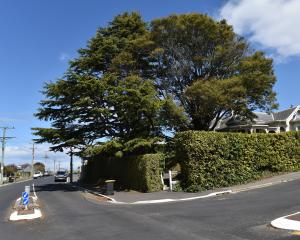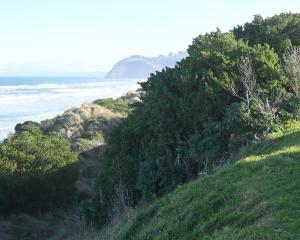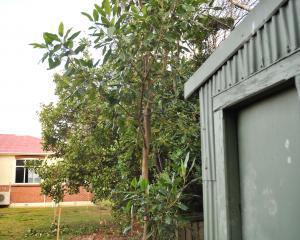

The Dunedin bus hub in Great King St is taking shape at last. I wonder what trees they'll plant to soften the impact of the all the extra bits and pieces, noise and bus activity in that part of the city.
In the meantime, there's a plucky little native tree battling for its share of the light in a row of ash trees beside the Countdown car park. It's in the same section of Great King St as the bus hub. Winter is the only time it gets noticed by most of us, with its evergreen leaves easy to see among the bare branches of its neighbours. It's a kohuhu (Pittosporum tenuifolium), also called at one time or another - wait for it - kohukohu, kowhiwhi, koihu, kaikaro, tawiri, tawhiwhi, tawhiri, rautawhiri, powhiri, pohiri, mapauriki, silverleaf, turpentine-tree, small-leaved tarata, black matipo and black birch (phew!). You get the feeling that Maori and early European settlers were quite fond of this unassuming little tree. They certainly would have come across plenty of them in and around the forests between Kaitaia and Bluff.
In fact, you could say that kohuhu is one of the "bread and butter" trees of the bush; with kahikatea, rimu, totara etc as the main course; and kowhai, rata, lacebark etc for dessert. Thankfully, there are still a lot of kohuhu in the surviving native forest near the coast of Southland and Otago (including the Dunedin Town Belt), and it's fairly common around the big lakes to the east of the Southern Alps.
I once asked Emeritus Prof Sir Alan Mark why introduced plants such as wilding conifers seemed to grow so much more vigorously than native plants in the same place. He told me that a lot of New Zealand species seemed to be rather "laid back" in their approach to life, meaning that they were attuned to pre-human New Zealand and weren't adapted to fighting for survival when faced with fierce competition from more aggressive aliens.
Well, kohuhu is less "laid back" than many New Zealand trees. Here in the South, it shows how tough it is by growing quite a lot higher up the sides of mountains than most of its lowland forest mates. You can see it clinging bravely to the cold, exposed slopes overlooking Lake Wakatipu and coping petty well on some very dry or shady patches in suburban gardens. For instance, when you drive from Concord to Green Island via Main South Rd, the "bushes" growing on the exposed, sunbaked road cutting to your left are kohuhu.
I confess that kohuhu leaves on their own aren't my favourite shade of green. An unkind person might even call them anaemic or insipid, especially the leaves on the many pale garden varieties people are fond of growing. You can see a few of these varieties thriving beside the south-facing wall of Dunedin Central Police Station.
The watery green hues of kohuhu look best next to something dark. Even the tree itself seems to appreciate that. Its bark is a sombre dark grey, and the small but cute summer flowers are a rich dark purple colour which fades to black.
Maori mixed kohuhu gum with other plant extracts to make perfume, ointment and a kind of chewing gum. Some of the other names for this tree suggest that it was and still is sometimes used to welcome visitors on to marae. I can't help feeling there are some cultural and business opportunities for enterprising southerners here.












